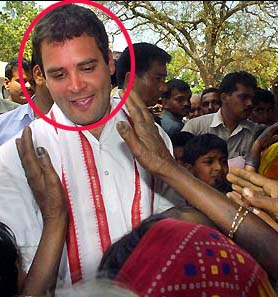`Sepoy' Rahul Gandhi enjoys interaction with Orissa tribals
 Nuapada/Kalahandi, Mar. 7 : Congress party general secretary and Lok Sabha MP from Amethi today toured Orissa's backward Kalahandi-Bolangir-Koraput region, and spent a considerable amount of time interacting with tribals and other underprivileged sections of society.
Nuapada/Kalahandi, Mar. 7 : Congress party general secretary and Lok Sabha MP from Amethi today toured Orissa's backward Kalahandi-Bolangir-Koraput region, and spent a considerable amount of time interacting with tribals and other underprivileged sections of society.
Congress party sources told ANI that Gandhi got a good and positive response from the people he met, and especially paid attention to their day-to-day problems. The people of the region, which is also known as the country's hunger zone, informed Gandhi that they were facing problems with water and electricity, and were yet to benefit from schemes like the National Rural Employment Guarantee Act (NREGA) and the National Rural Health Mission (NRHM).
During day one of his four-day visit to Orissa, which is presently governed by the opposition Biju Janata Dal-Bharatiya Janata Party combine, Gandhi laid thrust on key issues like unemployment, education, health, farmer and tribal issues.
Starting the day from Nuapada, he visited Sinapali Village to inspect the implementation of Western Orissa Rural Livelihoods Project.
This is a joint venture of the state government and DFID - Britain's Department for International Development. Due to repeated droughts, agricultural system has deteriorated in the Kalahandi region. Watershed Development projects were planned to help in reclamation of land, growth in agriculture and livelihood pattern.
The highlight of his first day in Orissa was an nteraction with various tribal groups of Kalahandi. In Lanjigarh, he interacted on a one to one basis with tribal groups such as Dongria and Jharnia. He also had lunch in atribal home and listened carefully to the problems of tribal folk.
Later, he addressed a "Jungle Bachao Rally" (Save The Forest Rally) at Bhawanipatana, where he emphasised that the Central Government has been sanctioning and releasing funds for the uplift of the poor and downtrodden, but these funds were getting lost or wasted in transit. Gandhi said that he was the representative of the Orissa tribal communities in Delhi and would do his best for them.
"I am your sepoy (soldier). I have had a family link with Orissa and it is my duty and will be my endeavour to see that the people of Orissa get their just due," said Gandhi.
After the rally, Gandhi visited Damanjodi in Koraput and interacted with forest dwellers from nearby villages.
He also interacted with representatives of the National Students' Union of India (NSUI), who sought to know how to make an entry into politics.
The scion of the Nehru-Gandhi family told them that entering politics was a difficult and long drawn out process. He said people desirous of entering politics needed to first register themselves as members of a political party, work assiduosly for that party in whatever assignments were given to them, and then slowly rise through the ranks to take on leadership roles.
One eight-year-old asked him "What is your dream for Orissa?" and Gandhi said he would like to see the state's identity change from from one of the most underdeveloped regions of the country, to a rich and vibrant entity. He said the state is rich in mineral resources and steps should be taken to safeguard it and use it for its development.
Gandhi's visit to Orissa's underdeveloped Kalahandi area assumes significance, as a controversy has arisen over a project to mine for bauxite in the Niyamgiri hills.
Tribals claim that the project will force them from their homes and destroy their livelihood.
Activists say the open-cast mine would also wreck the rich biodiversity of the hills. They will also disrupt key water sources that supply springs and streams in the area and feed two rivers which irrigate large farmlands.
From an environment conservation point of view, the Niyamgiri Hills is part of an elephant corridor which shelters leopards and is the only known home in Orissa of the rare golden gecko.
Over four days, Gandhi will visit as many 13 of the State's 30 districts. (ANI)